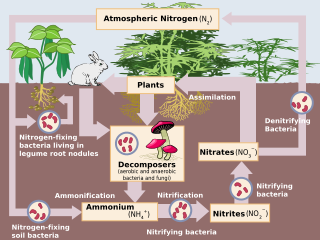Related Research Articles

Nitrification is the biological oxidation of ammonia to nitrite followed by the oxidation of the nitrite to nitrate occurring in separate organisms or direct ammonia oxidation to nitrate in comammox bacteria. The transformation of ammonia to nitrite is usually the rate limiting step of nitrification. Nitrification is an important step in the nitrogen cycle in soil. Nitrification is an aerobic process performed by small groups of autotrophic bacteria and archaea. The two step process was discovered by the Russian microbiologist Sergei Winogradsky in 1890.
Nitrosomonas europaea is a Gram-negative obligate chemolithoautotroph that can derive all its energy and reductant for growth from the oxidation of ammonia to nitrite and lives in several places such as soil, sewage, freshwater, the walls of buildings and on the surface of monuments especially in polluted areas where the air contains high levels of nitrogen compounds.

Nitrosomonas is a genus of Gram-negative bacteria, belonging to the Betaproteobacteria. It is one of the five genera of ammonia-oxidizing bacteria and, as an obligate chemolithoautotroph, uses ammonia as an energy source and as a carbon source in presence of oxygen. Nitrosomonas are important in the global biogeochemical nitrogen cycle, since they increase the bioavailability of nitrogen to plants and in the denitrification, which is important for the release of nitrous oxide, a powerful greenhouse gas. This microbe is photophobic, and usually generate a biofilm matrix, or form clumps with other microbes, to avoid light. Nitrosomonas can be divided into six lineages: the first one includes the species Nitrosomonas europea, Nitrosomonas eutropha, Nitrosomonas halophila, and Nitrosomonas mobilis. The second lineage presents the species Nitrosomonas communis, N. sp. I and N. sp. II, meanwhile the third lineage includes only Nitrosomonas nitrosa. The fourth lineage includes the species Nitrosomonas ureae and Nitrosomonas oligotropha and the fifth and sixth lineages include the species Nitrosomonas marina, N. sp. III, Nitrosomonas estuarii and Nitrosomonas cryotolerans.
Nitrobacter is a genus comprising rod-shaped, gram-negative, and chemoautotrophic bacteria. The name Nitrobacter derives from the Latin neuter gender noun nitrum, nitri, alkalis; the Ancient Greek noun βακτηρία, βακτηρίᾱς, rod. They are non-motile and reproduce via budding or binary fission. Nitrobacter cells are obligate aerobes and have a doubling time of about 13 hours.
Nitrifying bacteria are chemolithotrophic organisms that include species of the genera e.g. Nitrosomonas, Nitrosococcus, Nitrobacter, Nitrospina, Nitrospira and Nitrococcus. These bacteria get their energy by the oxidation of inorganic nitrogen compounds. Types include ammonia-oxidizing bacteria (AOB) and nitrite-oxidizing bacteria (NOB). Many species of nitrifying bacteria have complex internal membrane systems that are the location for key enzymes in nitrification: ammonia monooxygenase, hydroxylamine oxidoreductase, and nitrite oxidoreductase.
Paracoccus denitrificans, is a coccoid bacterium known for its nitrate reducing properties, its ability to replicate under conditions of hypergravity and for being a relative of the eukaryotic mitochondrion.
Hydroxylamine oxidoreductase (HAO) is an enzyme found in the prokaryote Nitrosomonas europaea. It plays a critically important role in the biogeochemical nitrogen cycle as part of the metabolism of ammonia-oxidizing bacteria.
Armatimonadetes is a phylum of gram-negative bacteria.
Ammonia monooxygenase (EC 1.14.99.39, AMO) is an enzyme, which catalyses the following chemical reaction
Nitrospira moscoviensis was the second bacterium classified under the most diverse nitrite-oxidizing bacteria phylum, Nitrospirae. It is a gram-negative, non-motile, facultative lithoauthotropic bacterium that was discovered in Moscow, Russia in 1995. The genus name, Nitrospira, originates from the prefix “nitro” derived from nitrite, the microbe’s electron donor and “spira” meaning coil or spiral derived from the microbe’s shape. The species name, moscoviensis, is derived from Moscow, where the species was first discovered. N. moscoviensis could potentially be used in the production of bio-degradable polymers.
Nitrosomonas eutropha is an ammonia-oxidizing, Gram-negative bacterium from the genus of Nitrosomonas.
Nitrosomonas halophila is an ammonia-oxidizing, aerobe, Gram-negative bacterium from the genus of Nitrosomonas. Nitrosomonas halophila uses the enzyme Ammonia monooxygenase.
Nitrosomonas marina is an ammonia-oxidizing, aerobe, gram-negative bacterium from the genus of Nitrosomonas.
Nitrosomonas nitrosa is an ammonia-oxidizing, aerobe, gram-negative bacterium from the genus of Nitrosomonas.
Nitrosomonas oligotropha is an ammonia-oxidizing, aerobe, gram-negative bacterium from the genus of Nitrosomonas which occurs in chloraminated drinking water systems.
Nitrosomonas ureae is an ammonia-oxidizing, aerobe, gram-negative bacterium from the genus of Nitrosomonas.
Streptomyces finlayi is a bacterium species from the genus of Streptomyces which has been isolated from soil from the plant Trifolium alexandrinum in Russia.
Microbacterium azadirachtae is a Gram-positive, non-spore-forming and motile bacterium from the genus of Microbacterium which has been isolated from the rhizoplane of the plant Azadirachta indica from the Botanical Garden of Coimbatore in India. Microbacterium azadirachtae can promote plant growth by producing phytohormones.
Mucilaginibacter polysacchareus is a Gram-negative, aerobic and non-motile bacterium from the genus of Mucilaginibacter which has been isolated from the rhizoplane of the plant Angelica sinensis in Geumsan in Korea. Mucilaginibacter polysacchareus produces exopolysaccharide.
Nitrosomonas halophila is an ammonia-oxidizing bacterium from the genus of Nitrosomonas.
References
- ↑ LSPN lpsn.dsmz.de
- ↑ Straininfo of Nitrosomonas communis
- ↑ Tokuyama, T; Mine, A; Kamiyama, K; Yabe, R; Satoh, K; Matsumoto, H; Takahashi, R; Itonaga, K (2004). "Nitrosomonas communis strain YNSRA, an ammonia-oxidizing bacterium, isolated from the reed rhizoplane in an aquaponics plant". J Biosci Bioeng. 98 (4): 309–12. doi:10.1016/S1389-1723(04)00288-9. PMID 16233712.
- ↑ NCBI Taxonomy Browser
- ↑ George M. Garrity: Bergey's manual of systematic bacteriology. 2. Auflage. Springer, New York, 2005, Vol. 2: The Proteobacteria Part C: The Alpha-, Beta-, Delta-, and Epsilonproteobacteria ISBN 0-387-24145-0